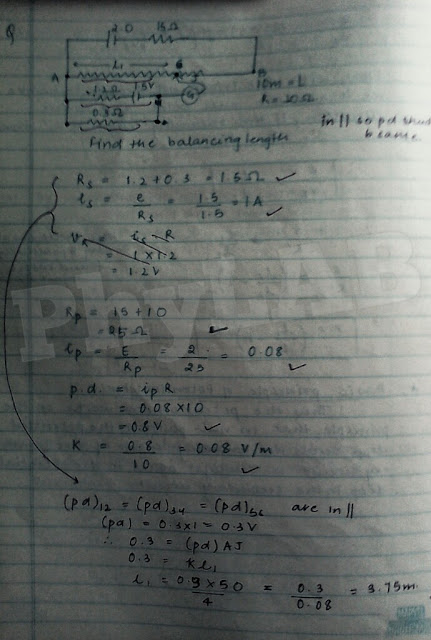Welcome to PhyLAB (Learn, Analyse & Build)... the process of learning and teaching Physics.... In this blog I welcome each and every students who are appearing for their Physics-ISC examination. I will try to upload questions, movies and other materials which I have been using as a teaching aid. We at PhyLAB make sure you win over your frustrations or helplessness while learning physics and its related concepts.
Saturday, June 27, 2015
Sunday, June 14, 2015
Thursday, June 11, 2015
Wednesday, June 10, 2015
Tuesday, June 9, 2015
Saturday, June 6, 2015
Friday, June 5, 2015
Electrostatics HOT1
- If the distance between two equal point charges is doubled and their individual charges are also doubled, what would happen to the force between them?
- The force between two point charges at a distance d apart is F. How this force changes if this system of charges is placed in a media of dielectric constant (relative permittivity) K?
- State Coulomb's law of force between two charges at rest. What is the force of repulsion between two charges of 1C each kept 1 m apart in vacuum?
- Coulomb’s Law in electrostatics is an example of “inverse square law”.
- State mathematically this law.
- Draw a graph between force and distance to represent the “inverse square law” relationship.
- State the expression for the constant of proportionality involved in the above law.
- The constant of proportionality is not a “universal constant”. State the factors on which the same depends.
- The Coulomb’s law in mathematical form may be represented as F= c q1.q2/r2
- State Coulomb’s law in words.
- What is the value of “c” in the above expression?
- Express ‘c’ in base (fundamental) unit.
- Two positive point charges of 12 and 8 micro coulomb are separated by a distance of 10 cm in air.
- Find the magnitude and direction of the force on the greater charge.
- How the force would be affected if:
- Each charge is replaced by a negative charge of the same amount.
- Only the greater charge is replaced by a negative charge of the same amount.
- Each charge is doubled and the distance is also doubled.
- Determine the net electric force on a test charge (q) placed at the origin in the shown charge combination.
- An important property of charges is that they are “quantized”.
- What do you understand by “quantization of charges”?
- Name the experiment which confirmed the same?
- Three charges +4q, Q and q are placed in a straight line of length “a” at points distant, 0, a/2 and a respectively. What should be Q in order to make the net force on q to be zero?
- The given figure shows pattern of electric field lines in space.(a) Identify at which point A or B, electric field is greater and why? (b) If a dipole is placed making some angle in such an electric field will it remain in translatory equilibrium or not. Explain (c) What you can say about its rotatory equilibrium? If not derive an expression for the torque experienced by such dipole.
- Three point charges, qa, qb, and qc are arranged at the vertices of right angled triangle as shown in the figure. What is the magnitude and direction of the electrostatic force acting on the third charge if qa = - 6.0 µC, qb = + 4.0 µC, qc = + 2.0 µC, a = 4.0 m and b = 3.0 m?
- Two insulated charged copper spheres A and B have their centers separated by a distance r meter apart. The charge on each is q Coulomb. (The radii of A and B are negligible as compared to the distance between them.)
- What is the force of repulsion between them?
- Let the spheres A and B has identical size. A third sphere C of same size but uncharged is brought in contact with first, then brought in contact with second and finally removed from both.
- Two plane parallel conducting plates 1.5x10-2 m apart are held horizontally one above the other in air. (a) Draw electric lines of forces in between the plates. (b) If the electric field in the region is 105N/m calculate the number of electrons which must be attached to a small oil drop of mass 4.9 x 10-5 kg held stationary between the plates, assuming that the density of air is negligible in comparison with that of oil. (ii) If the potential of the upper plate is suddenly changed to - 1.5 kV, what is the initial acceleration of the charged drop ? (iii) Also obtain the terminal velocity of the drop if its radius is 5•0 x 10-6 m and the coefficient of viscosity of air is 1.8 x 10-5 Ns/m2 (e = 1•6x10-19C).
Wednesday, June 3, 2015
Combination of Cell's or Batteries
EMF of a battery and Terminal Voltage and its relation with each other in different situation(s), such as (a) when discharging in a circuit, (b) in an open circuit and (c) while charging. It is advisable to the students that they must practice numerical problems based on such problems.
When the batteries are connected in series then the current (i) delivered in the circuit is as given below:
Batteries connected in parallel, with similar emf's (E) connected together:
Different emf's connected in parallel:
Subscribe to:
Comments (Atom)





























